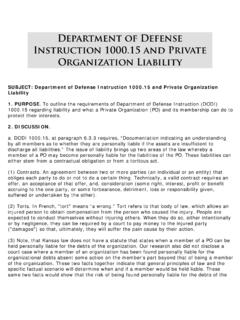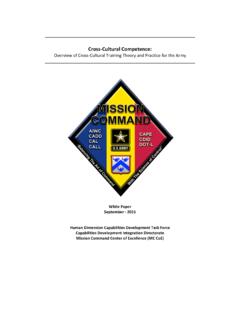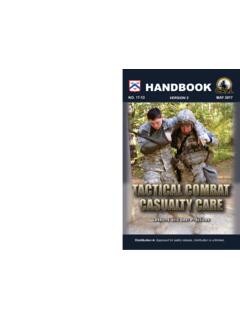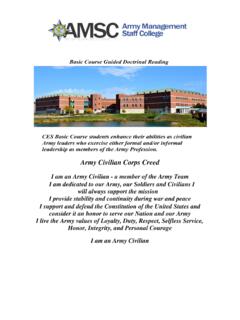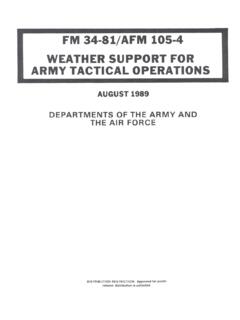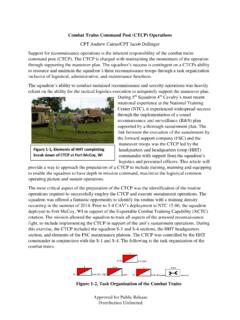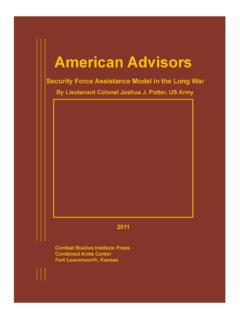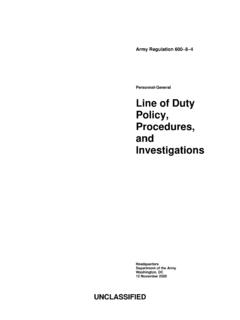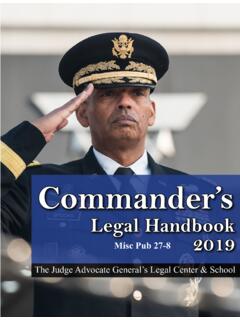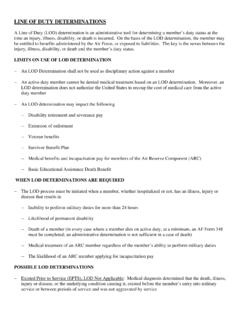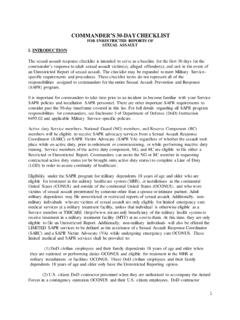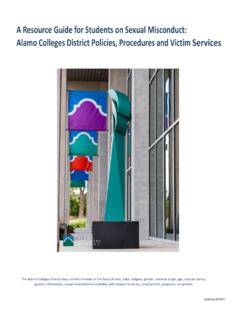Transcription of AR 15-6 Investigating Officer's Guide
1 AR 15-6 Investigating Officer's Guide A. INTRODUCTION 1. Purpose: This Guide is intended to assist Investigating officers who have been appointed under the provisions of Army Regulation (AR) 15-6, in conducting timely, thorough, and legally sufficient investigations. It is designed specifically for informal investigations, but some provisions are applicable to formal investigations. Legal advisors responsible for advising Investigating officers may also use it. A brief checklist is included at the end of the Guide as an enclosure. The checklist is designed as a quick reference to be consulted during each stage of the investigation . The questions in the checklist will ensure that the Investigating officer has covered all the basic elements necessary for a sound investigation .
2 2. THE PRIMARY DUTIES OF AN Investigating OFFICER ARE: a. to ascertain and consider the evidence on all sides of an issue, b. to be thorough and impartial, c. to make findings and recommendations warranted by the facts and comply with the instructions of the appointing authority, and d. to report the findings and recommendations to the appointing authority. 3. Authority: a. AR 15-6 sets forth procedures for conducting informal and formal investigations. Only informal investigations will be discussed here. Informal investigations are those that usually have a single Investigating officer who conducts interviews and collects evidence. In contrast, formal investigations normally involve due process hearings for a designated respondent.
3 Formal procedures are required whenever a respondent is designated. b. Informal procedures are not intended to provide a hearing for persons who may have an interest in the subject of the investigation . Since no respondents are designated in informal investigations, no one is entitled to the rights of a respondent, such as notice of the proceedings, an opportunity to participate, representation by counsel, or the right to call and cross-examine witnesses. The Investigating officer may, however, make any relevant findings or recommendations concerning individuals, even where those findings or recommendations are adverse to the individual or individuals concerned. c. AR 15-6 is used as the basis for many investigations requiring the detailed gathering and analyzing of facts and the making of recommendations based on those facts.
4 AR 15-6 procedures may be used on their own, such as in an investigation to determine facts and circumstances, or the procedures may be incorporated by reference into directives governing specific types of investigations, such as reports of survey and line of duty investigations. If such directives contain guidance that is more specific than that set forth in AR 15-6 or these procedures, the more specific guidance will control. For example, AR 15-6 does not contain time limits for completion of investigations; however, if another directive that incorporates AR 15-6 procedures contains time limits, that requirement will apply. d. Only commissioned officers, warrant officers, or DA civilian employees paid under the General Schedule, Level 13 (GS 13), or above may be Investigating officers.
5 The Investigating officers must also be senior to any person that is part of the investigation if the investigation may require the Investigating officer to make adverse findings or recommendations against that person. Since the results of any investigation may have a significant impact on policies, procedures, or careers of government personnel, the appointing authority should select the best qualified person for the duty based on their education, training, experience, length of service, and temperament. B. PRELIMINARY MATTERS 1. Appointing authority. a. Under AR 15-6, the following persons may appoint Investigating officers for informalinvestigations: - any general court-martial convening authority, including those who have such authority for administrative purposes only, - any general officer, - a commander at any level, - a principal staff officer or supervisor in the grade of major or above, - any state adjutant general, and - a DA civilian supervisor paid under the Executive Schedule, SES, or GS/GM 14 or above, provided the supervisor is the head of an agency or activity or the chief of a division or department.
6 B. Only a general court-martial convening authority may appoint an investigation for incidents resulting in property damage of $1,000,000, the loss or destruction of an Army aircraft or missile, an injury or illness resulting in, or likely to result in, total disability, or the death of one or more persons. 2. Appointment procedures. Informal investigation appointments may be made orally or in writing. If written, the appointment orders are usually issued as a memorandum signed by the appointing authority or by a subordinate with the appropriate authority line . Whether oral or written, the appointment should specify clearly the purpose and scope of the investigation and the nature of the findings and recommendations required.
7 If the orders are unclear, the Investigating officer should seek clarification. The primary purpose of an investigation is to report on matters that the appointing authority has designated for inquiry. The appointment orders may also contain specific guidance from the appointing authority, which, even though not required by AR 15-6, nevertheless must be followed. For example, AR 15-6 does not require that witness statements be sworn for informal investigations; however, if the appointing authority requires this, all witness statements must be sworn. 3. Obtaining assistance. The servicing Judge Advocate office can provide assistance to an Investigating officer at the beginning of and at any time during the investigation .
8 Investigating officers should always seek legal advice as soon as possible after they are informed of this duty and as often as needed while conducting the investigation . In serious or complex investigations for which a legal review is mandatory, this requirement should be included in the appointment letter. Early coordination with the legal advisor will allow problems to be resolved before they are identified in the mandatory legal review. The legal advisor can assist an Investigating officer in framing the issues, identifying the information required, planning g the investigation , and interpreting and analyzing the information obtained. The attorney s role, however, is to provide legal advice and assistance, not to conduct the investigation .
9 4. Administrative matters. As soon as the investigation officer receives appointing orders, he or she should begin a chronology showing the date, time, and a short description of everything done in connection with the investigation . The chronology should begin with the date orders are received, whether verbal or written. Investigating officers should also record the reason for any unusual delays in processing the case, such as the absence of witnesses due to a field training exercise. The chronology should be part of the final case file. 5. Concurrent investigations. An informal investigation may be conducted before, concurrently with, or after an investigation into the same or related matters by another command or agency.
10 Appointing authorities and Investigating officers must ensure that investigations do not hinder or interfere with criminal investigations or investigations directed by higher headquarters. In cases of concurrent investigations, Investigating officers should coordinate with the other command or agency to avoid duplication of effort wherever possible. If available, the results of other investigations may be incorporated into the AR 15-6 investigation and considered by the Investigating officer. Additionally, an Investigating officer should immediately coordinate with the legal advisor if he or she discovers evidence of serious criminal misconduct. C. CONDUCTING THE investigation 1.
